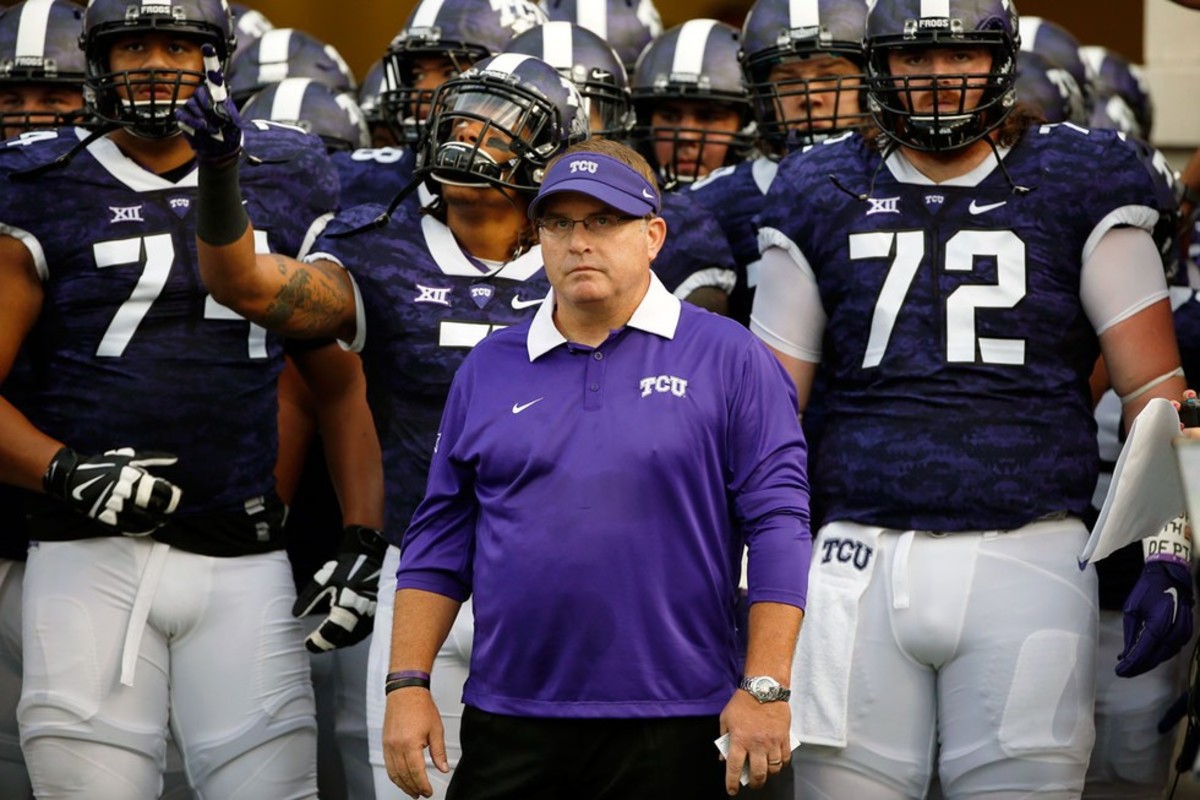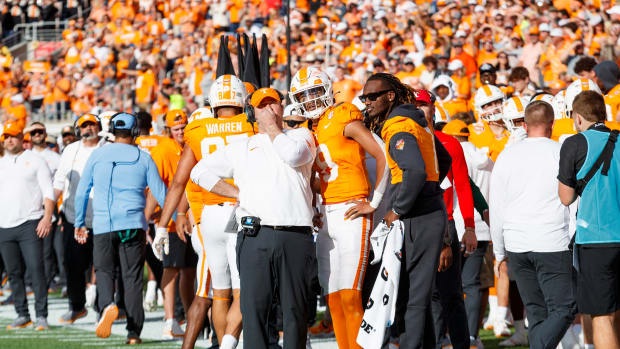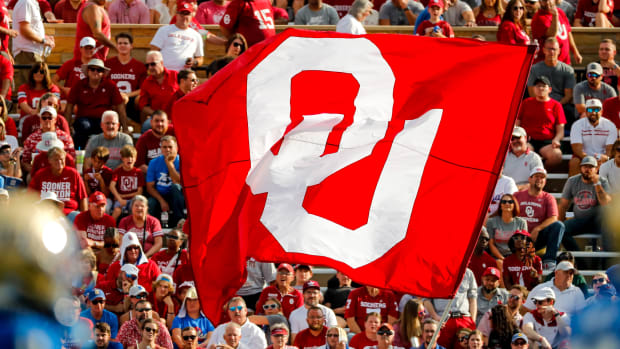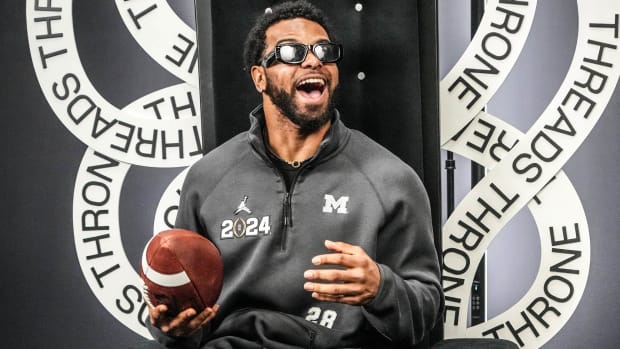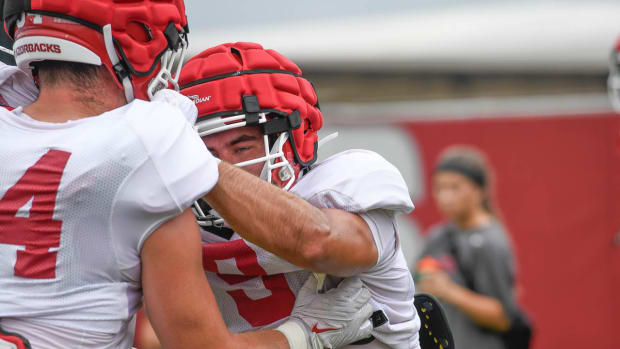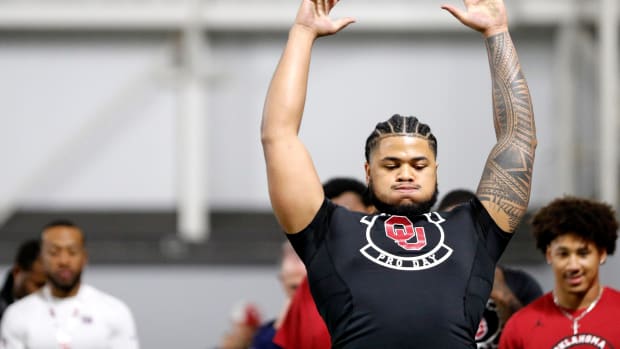The Big 12's playoff push: Entering a loaded November schedule, is the league positioned to make the field?
FORT WORTH, Texas—Gary Patterson will not engage in the political process this early, and he hopes he doesn't have to bother with it at all. "I'm not going to try to talk to the committee," the TCU coach said after his team's 40–10 win over West Virginia last week.
Then Patterson asked a series of questions that proves just how much Patterson's world has changed since the head coach who calls his own defense brought his team into the Big 12 four years ago. "All I've been hearing is we can't play defense. … I keep hearing that to be one of those four teams [in the College Football Playoff] you have to be the four most complete teams," Patterson said. "Why is that? Why is it you can't just outscore people and go win the game? Why is it you have to be the most complete team? I just have to hold them to one [point] less. Right now, we're going to worry about Oklahoma State."
The Gary Patterson of 2005 probably wouldn't have suggested that a team that wins games with final scores like 55–52 (TCU's score at Texas Tech on Sept. 26) should be competing for a national championship. But that's the reality of the current Big 12. And Patterson isn't wrong. The fact that the league's offenses are better than its defenses shouldn't preclude Big 12 teams from making the playoff. LSU's defense was considerably better than its offense in 2011, and the Tigers put together one of the best regular-season résumés in college football history and made the BCS title game. (Then lost a rematch with Alabama because their offense couldn't score.) The issue with the Big 12 at the moment isn't stylistic. It's temporal. Big 12 leaders opted to backload their schedule so all the best teams would play one another in November. Meanwhile, Baylor (7–0), Oklahoma (7–1), Oklahoma State (8–0) and TCU (8–0) opted to play no teams better than Tennessee (an Oklahoma opponent currently sitting at 4–4) and Minnesota (a TCU opponent currently sitting at 4–4) in their nonconference slates. So, the playoff selection committee has very little good-on-good data for the best Big 12 teams. But that's about to change.
TCU's visit to Stillwater on Saturday kicks off what could be the wildest month in Big 12 history. A week later, Oklahoma visits Baylor. The following week, Baylor visits Oklahoma State and Oklahoma visits TCU. The week after that, Baylor visits TCU and Oklahoma visits Oklahoma State. This will all get settled.
Maybe.
Ronald Martinez/Getty Images
If one of Baylor, Oklahoma State or TCU survives this gauntlet undefeated, it's a safe bet that team will make the playoff. The quality opposition question will have been answered in November, and history suggests the other three Power Five leagues that still have undefeated teams won't all have undefeated champions. Oklahoma, with its more-mind-bending-by-the-week loss to Texas, might still need help even if it goes 3–0 against the other heavyweights. That sentiment goes for any of these teams if they emerge from this scrum as a one-loss Big 12 champ. That team would have a chance to make the playoff, but it would have to makes its case against teams that don't necessarily look or play the way they play in the Big 12.
The preferences of committee members will come into play at that point, and it will be interesting to see which stats they use to compare teams. So far, we've been told they use advanced stats such as Strength of Record and Game Control. These are proprietary ESPN stats but aren't that mysterious. Strength of Record calculates how difficult it was to for a team to achieve its record against its specific schedule. Game Control is a calculation of average in-game win probability. Hopefully, the committee also uses other advanced stats—and a few less advanced ones—and ignores some of the more traditional ones that do a lousy job of explaining a game that is played very differently than it was 10 years ago.
For example, if committee members are using total defense or total offense to compare teams from different leagues, they might as well be comparing batting averages or free throw percentages. Those numbers are essentially meaningless when comparing, say, the TCU-Texas Tech game with the Florida State-Georgia Tech game. Oklahoma State's Mike Gundy put it quite well this week when describing the defensive stats he and his staff hope to optimize. "I don't believe in the defensive statistics that are out here today," Gundy told reporters. "I've said that several times. For two years, I've said that. Defensive statistics need to be based on a percentage of possessions defended and points based on the possessions you defend in a game."
Such stats exist, and they don't all use proprietary formulas. Some are just basic math. Advanced stats guru Brian Fremeau keeps a Points Per Drive stat on his site that examines how many points defenses allow per possession. The stat measures only FBS vs. FBS games and throws out garbage time and end-of-first-half, clock-killing possessions. It allows for a more apples-to-apples comparison of defenses that play varying styles of offense. And because Fremeau calculates the same stat for offenses, we can examine the net difference in points per possession scored and points per possession allowed by one team.
Traditional statistics suggest that Gundy's Cowboys rank No. 41 in the nation in total defense at 357 yards allowed per game. This number is skewed in one direction by the number of possessions Oklahoma State's defense faces in the Big 12—the Cowboys faced 16 in a 70–53 win at Texas Tech last Saturday—and skewed in another direction by the 220 total yards the Cowboys allowed in a 32–8 win over FCS Central Arkansas on Sept. 12. Oklahoma State ranks a more respectable No. 31 in points allowed per drive (1.67) against only FBS opponents. And since Oklahoma State's offense ranks No. 12 in points scored per drive (2.99), the net of 1.31 points is good for No. 15 in the country.
Jared Wickerham/Getty Images
TCU ranks three spots ahead of Oklahoma State in net points per drive (1.38), but a look at the offensive and defensive breakouts show how a turnover or two might swing the game in the underdog Cowboys' favor. TCU ranks No. 3 in points scored per drive (3.54) but No. 69 (2.17) in points allowed per drive. Though the Horned Frogs' defense has improved in recent weeks as injured veterans have returned to the lineup and thrown-in youngsters have gained experience, this could be troubling against an Oklahoma State offense that thrives with either sophomore Mason Rudolph or redshirt senior J.W. Walsh at quarterback.
For comparison's sake, let's look at some other playoff contenders. Baylor ranks No. 1 in net points per drive (2.76), but that can be easily dismissed as a product of the Bears' weak schedule to this point. If they're still at No. 1 on Dec. 6, they should probably be in the playoff. Ohio State is No. 6 (1.75), but that high ranking can be dismissed almost as easily as Baylor's and will carry more weight once data from the Michigan State (Nov. 21) and Michigan (Nov. 28) games is added. Alabama sits at No. 17 (1.3) because a less productive offense (2.29, No. 47) is dragging down a stellar defense (0.98, No. 2). Still, those numbers carry more weight because the Crimson Tide have played better competition than the two teams mentioned above.
Does the committee consider any of this? We don't know. Texas Tech athletic director Kirby Hocutt employs a coach who runs an up-tempo offense, so he seems likely to advocate against traditional stats. The three ex-coaches on the panel are Barry Alvarez, Tom Osborne and Tyrone Willingham. While none coached in the high-tempo era—other than Alvarez's return for last season's 34–31 overtime win against decidedly up-tempo Auburn in the Outback Bowl—Osborne was known for his willingness to experiment on offense. (He used option principles, but he adjusted the scheme frequently to highlight the best attributes of the players he had at the time.) Alvarez, Wisconsin's athletic director, has made his feelings quite plain about spread offenses. In 2010, after his team beat an Ohio State squad running an offense that was a slower-paced, Jim Tressel-ized version of what the Big 12 teams run, Alvarez couldn't help but crow. "We play football," Alvarez said that night. "And I love it."
Hopefully the committee members, most of whom came of age in an era when football much more closely resembled what LSU plays than what TCU and Oklahoma State play, will understand there is more than one way to move a pigskin. While it isn't easy to compare such disparate styles, it's the committee's job to do just that. And if committee members are too nostalgic, then the only shot at the playoff for Baylor, Oklahoma State or TCU might be to simply outscore everyone, finish 12–0 and eliminate any doubt.
